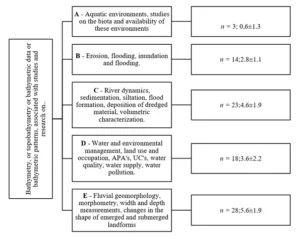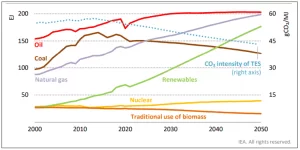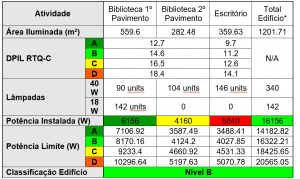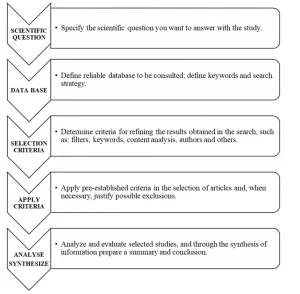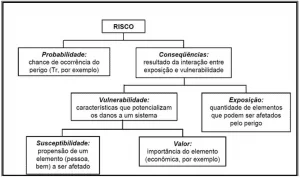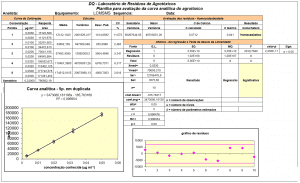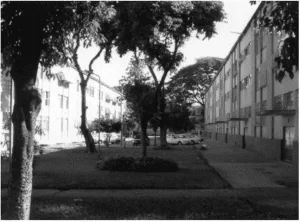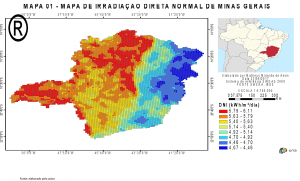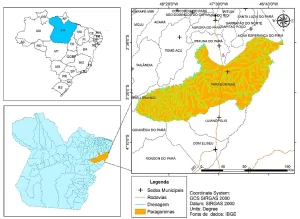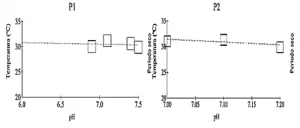ORIGINAL ARTICLE
MAZZEI, João Roberto Fortes [1], FREIRE, Estevão [2], SERRA, Eduardo Gonçalves [3], MACEDO, José Ronaldo de [4], OLIVEIRA, Angélica Castanheira de [5], BASTOS, Lucia Helena Pinto [6], CARDOSO, Maria Helena Wohlers Morelli [7]
MAZZEI, João Roberto Fortes. Et al. Field research: A comparative analysis between conventional, organic and sustainable methods of tomato production. Revista Científica Multidisciplinar Núcleo do Conhecimento. Year 06, Ed. 02, Vol. 05, pp. 125-146. February 2021. ISSN: 2448-0959, Access link: https://www.nucleodoconhecimento.com.br/environmental-engineering-en/tomato-production, DOI: 10.32749/nucleodoconhecimento.com.br/environmental-engineering-en/tomato-production
ABSTRACT
Agriculture represents one of the main pillars of the Brazilian economy, its importance being related to food security and the generation of job opportunities. However, it is necessary to have a critical reflection on the sustainability of planting. Among the different types of crops, tomatoes stood out as one of the most planted and consumed fruits in the world. This article provides a comparative assessment between three types of tomato planting: conventional, organic and sustainable (TOMATEC®), from soil preparation to commercialization on the market. The work was carried out in the north of the state of Rio de Janeiro, together with groups that produce the fruit in these three types of planting. The methodology was based on an unstructured questionnaire, with free responses, applied to farmers in the region. We believe that this study will contribute to the orientation of society through data obtained from serious information processing criteria. The main results showed, through the sustainable planting system of EMBRAPA (innovation), that it is possible to use pesticides with environmental awareness and produce fruit free of residues. Diseases, in the conventional system, are controlled by the application of fungicides and bactericides. In sustainable planting, a mixture of homemade detergent with soy oil, Bordeaux mixture, cow’s milk, contact fungicides and systemic fungicides is used, and in the organic production system, it is common not to let the disease settle in the plant, through preventive control of soil preparation and protection. In pest control, the conventional system performs the application of insecticides composed of various active principles. In the organic system, the control of insects is privileged by balancing the soil, with this, the plants acquire greater resistance to diseases and pests. In the sustainable system, there is no preventive treatment, but curative. Market fruit prices for conventional planting fluctuate and depend on supply, while tomatoes from organic and sustainable systems do not fluctuate. Organic production does not have the installed capacity to meet market demands. With this, the sustainable system has been gaining space in the market and expanding in the Southeast and South of the country.
Keywords: Agriculture, tomato, competitiveness, planting systems.
INTRODUCTION
The environmental crisis in the current world is characterized, among other factors, by the growing process of global warming, generated by the huge and increasing volume of CO2 emissions and other greenhouse gases, by the degradation of biotic and abiotic systems, by deforestation, by high volume of harmful liquid effluents discharged into the waters and the depletion of renewable and non-renewable natural resources (WHATELY, 2016).
The world population reached 7.7 billion in mid-2019, seeing growth of one billion people since 2007 and, according to estimates, is expected to reach 9.7 billion in 2050 (UN, 2020).
The high losses suffered by agriculture due to the infestation of pests and weeds, in addition to diseases and soil wear, make it necessary to use pesticides in production. For these and other factors, the use of pesticides must be carried out in a rational manner, since the indiscriminate use of these products can cause negative impacts on the environment, harming the health of workers and consumers who directly and / or indirectly handle such substances (CARNEIRO, 2015).
Agricultural production in Brazil is dominated by the large-scale production model, with intense mechanization on the properties and which use high volumes of pesticides. The use of sustainable agriculture, as exposed in this work, is a proposal for a solution for soil degradation that can be systematic, if adopted on a large scale, either by the action of markets or by state regulation (BACCARIN, 2020).
According to Araujo (2018), tomatoes are one of the main products planted and commercialized by world agriculture. The author comments that, due to the easy adaptation to the different types of soil and the climate, the tomato culture is one of the most widespread in the world.
In 2017, world tomato production totaled 170.8 million tons, with China, the world’s leading tomato producer, accounting for 31% of total production, followed by India and the United States (NAG, 2017).
In order to meet the demands of the markets, the use of pesticides in tomato plantations is becoming increasingly greater and the residues of these chemicals are one of the biggest problems of this food on the table of the final consumer and planters (ESALQ, 2017).
In Brazil, ANVISA references (2018) authorize 500 active ingredients for application in agriculture. Of this amount, 119 pesticides are used in planting tomatoes, and the same active ingredient can be marketed under the labeling of many formulations and trade names, in addition to mixtures containing more than one active ingredient in the same product (BRAIBANTE, 2012).
According to SEMACE (2014), Brazil has 1,454 pesticide brands available, including insecticides, herbicides, fungicides, nematicides, fumigants and other organic compounds, in addition to growth regulators, defoliants and desiccants.
According to the Ministry of Agriculture (MAPA, 2019), the Brazilian government authorized the release of 63 more pesticides in September 2019, seven new ones and the total number of registrations in 2019 reaches 325 pesticides, an increase in release in the year that it is already the highest in the history of pesticides in the country.
According to the National Union of Plant Protection Products Industry (SINDIVEG), in 2019, approximately R$ 21 billion were financed for purchases of pesticides, in lines of credit for rural producers. The agency mentions that 5,000 direct jobs were generated and around 15,000 indirect beneficiaries. R$ 354 million was invested in fixed assets, research and development, in addition to the collection of R$ 548 million between federal, state, municipal taxes and regulatory fees. These data reinforce Brazil’s monoculture export characteristic, in which about 75% of the total of pesticides imported by the country are destined for only three agricultural crops.
According to Mazzei (2021), the use of pesticides can generate impacts on human health and the environment, which can lead to possible soil contamination. The author cites the sustainable system (TOMATEC® – unconventional production by EMBRAPA), as a highly successful alternative in reducing the socioenvironmental impacts generated by the current tomato production model. However, according to the research, as it is a relatively new system, there are still no studies comparing the three systems. Thus, this work aimed to make such comparisons and started from the following premises:
- Conventional planting with intensive use of pesticides may not be environmentally friendly;
- In comparison with the organic system, the sustainable system provides greater production volume, greater flexibility of use and complies with the legislation.
The research methodology for the validation of the hypotheses was of the descriptive-exploratory type with the application of a questionnaire for tomato farmers in each region where the soil samples were collected.
Carvalho (2016) carried out a similar study, comparing the use of pesticides and the management of tomato crops in the municipality of Cambuci for conventional and organic plantations. The objective of the study was to know details about planting in both systems, from sowing to harvesting the fruits. The author applied a questionnaire of the unstructured type, with free answers.
This study retrieved data from Carvalho’s research (2016), however with the inclusion of sustainable planting. The survey was carried out by applying a questionnaire of the unstructured type, with free responses, and was carried out between January 17 and 22, 2020.
The research was applied to seven plantations in the metropolitan regions (municipality of Tanguá – Mutuapira district and São Gonçalo – Monjolos district); Serrana (Municipality of Trajano de Moraes – district of Tirol) and Nova Friburgo (Três Picos – 3rd District), regions representing the three types of tomato cultivation (conventional, sustainable and organic system) in the state of Rio de Janeiro.
THE TOMATO CULTURE
Tomato is a vegetable widely consumed “in natura“, usually in salads, sauces and sandwiches. Tomato planting is subject to attack by pests and diseases.
The whitefly is one of the main pests that affect this fruit, with Bemisia argentifolii and Bemisia tabaci, the two main species of whitefly responsible for damage to tomato cultivation. Morphologically, there is no difference between the two species. However, the former is significantly more aggressive, since it has a higher reproduction rate, affects a greater number of host plants and manages to complete its entire life cycle in tomatoes, in addition to being highly resistant to adverse environmental conditions and some conventional pesticides. (ESALQ, 2017).
Insecticides and fungicides are the products most used by the farmer when planting tomatoes, due to the disease called late blight, caused by the insect, Phytophthora infestans, which is harmful to this crop. For this reason, chemical control constitutes about 30% of the production costs of the crop. Late blight is still a difficult disease to control, even with the use of fungicides with a wide spectrum of action (FIORINI, 2010).
Payer (2010) carried out studies on the tomato moth – Tuta absoluta (Meyrick) (Lep .: Gelechiidae) and mentions that the pest attacks several types of solanaceae, preferably tomato. The author comments that the peak of pest infestation occurs in the first days after planting and coincides with the driest months of the year, noting that, although the tomato grows all year, the wettest period reduces the pest population .
Moreira (2013) reinforces the information that the tomato moth has its peak of infestation during the months of January and February. The author adds that the life cycle of the tomato moth is 38 days and that the egg phase lasts between three and six days, with the eggs being deposited on the stems, flowers, fruits and leaves of the upper part of the plant.
In his research, Carvalho (2016), informs that about 60% of the farmers make up to two applications of pesticides weekly. According to the work, farmers describe that if diseases arise or the weather is rainy, there is a need for a greater number of applications, which can reach three times a week. Also according to this work, the most cited insecticide brands were: Verimec (89.47%), Actara (82.46%) and Karate (75.44%). The first two are classified as moderately toxic and the third as highly toxic.
PLANTING SYSTEMS STUDIED
CONVENTIONAL TOMATO PLANTING SYSTEM
Nascimento (2013) notes that due to the great demand for the fruit, the need for large-scale production and the great sensitivity of the tomato to the attack of pests, diseases and weeds, to avoid losses in cultivation, conventional tomato production ends up being based in the use of synthetic chemicals (pesticides, herbicides, fertilizers). The author mentions that this causes serious problems of public health and environmental contamination, above all, of water resources.
Santiago (2014), comparing conventional and organic agriculture, points out that the biological control of the tomato moth in organic agriculture is done with Trichogramma pretiosum Riley (Hym .: Trichogrammatidae). However, in conventional agriculture, due to the need for immediacy and high productivity, the purely biological defense does not show good performance, and it is necessary to resort to the application of pesticides.
Few farmers have considered natural biological control by conserving natural enemies in conventional agriculture (EHLERS, 2017).
Payer (2011) comments that biological control is more effective when adopted in the egg phase, because, in this way, the probability of losses in planting is attenuated.
ORGANIC TOMATO PRODUCTION SYSTEM
According to Alves (2012), organic agriculture consists of a set of agricultural production processes based on the premise that fertility is a direct function of the organic matter present in the soil. It is a planting system that does not use pesticides and has been expanding all over the world, with Brazil occupying the second position in Latin America in organic production. However, for Alvarenga (2013), organic production has no installed capacity to meet production demands and the population’s needs, since diseases and pests limit the expansion of cultivation in this system.
The action of microorganisms in the substances present or added to the soil of organic planting provides the supply of mineral and chemical elements fundamental to the development of cultivated vegetables. In addition, the presence of a microbial population attenuates the interference from human intervention in the environment. Thus, organic agriculture is a form of cultivation that establishes good practices for the formation of environmentally balanced and friendly agricultural systems, economically productive and of high efficiency. In the organic system, adequate food and a healthy environment result in more vigorous plants that are more resistant to pests and diseases, eliminating the use of other resources, such as the use of pesticides and chemical fertilizers (NASCIMENTO, 2013).
Wives (2015) comments that organic agriculture aims to work in such a way that ecological interactions and synergy between them act on soil fertility. According to the author, the conditions of humidity and aeration, together with the balance of the environment are the factors that determine the survival and maintenance of these micro-organisms, allowing their use as agents of protection and soil preservation. For this reason, one of the main aspects considered in organic crops is the introduction and maintenance of microorganisms in the soil, in order to maintain the conditions conducive to biological transformation.
Bastian (2018) suggests that to be considered organic, planting must start in new facilities and be limited to the use of soils that have never been explored before. However, the suggestion goes against the very principles postulated by organic production, since planting in new lands would promote deforestation and lead to environmental imbalances. Thus, the conversion of conventional agriculture to organic management is the recommended process, even though it needs more time to consolidate and is more costly.
Normative Instruction 007/2016, of the Ministry of Agriculture, Livestock and Supply (MAPA, 2016), in its item 1.1, considers as
organic agricultural and industrial production system any one in which technologies are adopted that optimize the use of natural and socioeconomic resources, respecting cultural integrity and aiming at self-sustainability in time and space, maximizing social benefits, minimizing dependency non-renewable energies and the elimination of the use of pesticides and other toxic artificial inputs, genetically modified organisms (GMOs) / transgenics or ionizing radiation at any stage of the production, storage and consumption process, privileging the preservation of environmental and human health, ensuring transparency at all stages of production and processing.
INNOVATION – SUSTAINABLE SYSTEM – SPD (TOMATEC)
According to Vieira (2014), a planting system that contemplates environmentally friendly production and that meets the market needs for tomatoes has not yet emerged.
An alternative form of cultivation for planting tomatoes emerged after research by Embrapa Solos and consists of the production of tomatoes in sustainable cultivation. The system is based on the implementation of soil and water conservation techniques, with a no-tillage system on straw (SPD – no-tillage system), which is planting without soil overturning (MACEDO, 2016).
The SPD aims to maintain the soil throughout the year, taking advantage of the biodiversity of the plants in development (grasses), which are responsible for covering the soil, or with aerial parts and / or with their residues (dead straws) and living roots.
In this planting system, Macedo (2016) highlights the differentials that allow the production of tomatoes in a sustainable way and at scales much higher than that offered by organic production, which are: conservationist soil planning, drip irrigation and fertilization through irrigation water itself (fertigation), in addition to the use of ribbons for the vertical orientation of plant growth, promoting air circulation and facilitating budding; integrated pest management (IPM), as a way of monitoring crop pests and diseases. The SPD adopts the physical protection of the fruits, carried out by bagging the tomato clusters with glassyne paper or granapel (Figures 1 and 2), which allows a significant reduction in the use of pesticides in tomato crops. According to the author, these allied factors promote a significant reduction in the number of pesticide applications in the plantation and make it possible to obtain a fruit without pesticide residues and, thus, add value to the product.
The philosophy of this planting method is based on the change of posture and environmental awareness of farmers, in which exclusively manual routines are replaced by technical activities of observation and monitoring of plant growth. In this way, the energy expenditure in the digging and staking stages during the conduction of the crop is replaced by the gain in quality of control of the plantation with the integrated management of pests and the bagging of the fruits. According to the author, the results are fruits of a high level of quality and production that can compete with the results of conventional planting.
Figure 1 – Bagging the tomato bunches with glassyne paper or granapel – Right time for bagging
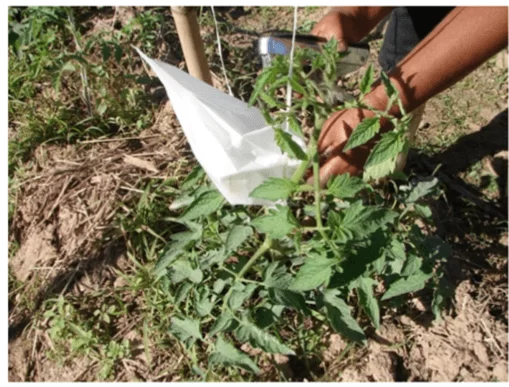
Figure 2 – Tomato bagging technique
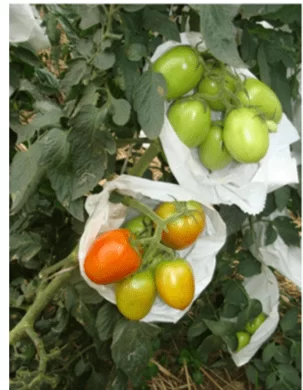
The system has already had its fruits validated by the INCQS / FIOCRUZ laboratory regarding the maximum residue limit recommended by ANVISA.
RESULTS AND DISCUSSION
Based on the questionnaire answered by the farmers, it was possible to know details about planting in the three systems, from sowing to the market situation of the fruits. The answers obtained to the applied questionnaire are discussed below and, depending on the case, opposed to the literature.
TREATMENT OF SEEDLINGS
In conventional tomato planting, pesticides are applied three to four times a week in the hottest seasons of the year (spring and summer) and, in the coldest seasons (autumn and winter), between one and two times. In the organic system, sprays are made with Bordeaux mixture only when necessary. The sustainable system, on the other hand, uses a mixture of biological control, Bordeaux mixture, bagging, insecticides and fungicides, in quantities up to ten times smaller than those used in conventional planting.
SUBSTRATE USED
In the conventional system, substrates are used, especially products based on recycled organic waste. In the organic system, a commercial substrate suitable for certified organic planting is applied and 20% earthworm humus is added. In the sustainable system, coconut substrate, fertilization with organic residues (manure) and chemical fertilization are used.
PEST CONTROL METHODS
In the conventional system, the preventive application of insecticides formulated from different active principles (Permethrin, Fenpropatrin, Phosphorus Aphosphate, Phosphorus Paration Methyl, Biological, Physiological Clorfluazuron) is carried out, with frequency that, depending on the period of the year, can reach up to one application per week in the winter, reaching three in the summer. In the organic system, the control of insects is privileged through the balance of the soil, which allows the plants to have balanced nutrition and, with this, acquiring greater resistance to pests. Biological control methods based on Trichogramma pretiosum, biological insecticides based on Bacillus thurigiensis extracts (bacteria harmful to insects), are also applied in the organic system; sulfur, for controlling mites; pheromones of sexual attraction that confuse insects and prevent them from mating with their partners and extract of neem (plant that repels insects). The last two are only applied in case of high infestation in the organic system.
In the organic system, plants are grown that attract pest insects and their predators. These plants are strategically placed outside the greenhouse. In the sustainable system, there is no preventive treatment, but a curative one, such as: neem extract, detergent with soy oil to treat the whitefly and insecticides (only in extreme cases), since the plant is protected by bagging since flowering and the involvement of pests is less.
DISEASE CONTROL METHODS
In the conventional system, disease control is carried out using fungicides and bactericides. In the organic production system, it is common not to let the disease settle in the plant and, for this, preventive control is done through the preparation and protection of the soil. According to the planters of this system, only in rare cases, disease control is done with the application of Bordeaux mixture. In sustainable planting, a mixture of homemade detergent with soy oil, Bordeaux mixture, cow’s milk, contact fungicides and systemic fungicides is used.
WEATHER CONTROL METHODS
Many herbicides are registered and used in tomato planting using the conventional system. In the organic system, plants called weeds are used, depending on the case, as partner plants and coexist among tomato plants, helping to protect the soil from erosion and the impact of water droplets. Weeds still function as indicators of soil conditions, such as pH, nutritional deficiencies, among others, supporting the supply of organic matter. Thus, the organic system uses only manual weeding, in order to avoid competition for light. In the conventional system, the straw distributed by the plantation has the objective of inhibiting weeds and controlling humidity.
CULTIVATION
Both in the organic and conventional systems, the treatment of the crop involves the elimination of shoots from the grafts, reduction of the excessive number of fruits per clump (creation of a space that allows greater growth, increasing the size of the fruits), orientation of the growth of the plants. plants through cuttings (crossed or parallel), pruning of the extremities to strengthen the growth and robustness of the plants and removal of the protection rods of the tubers.
In the organic system, conduction with two stems produced more fruits, when compared with conduction with one stem, with a greater number of fruits and with better quality per plant. In the sustainable system, conduction tapes with one plant and two rods are used, which allows greater aeration of the system and less need for pesticide application.
In the sustainable system, the treatment of the crop is carried out with a mix of the techniques adopted in conventional and organic planting, that is, based on sprouting; grating, clump, weeding and mulching with grass from the site itself. However, the system brings as a great advantage the staking with strips for conducting the plant, integrated pest management (MIP), which serves as an indicator of differential control; bagging of the hands with glassyne paper and granapel and fertigation.
WORKPLACE USED
Conventional cultivation requires fewer workers per hectare than the other two cropping systems. A single worker can manage 3000 plants in this system. In the organic system, there is a need for one worker for every 1000 plants and in the sustainable system, a worker for 2000 thousand plants. The higher number of people involved in the organic and sustainable systems is due to the treatment steps, such as preparing the syrups, the organic compost, the mulch and the weeding (performed manually), which, in general, are not adopted by the conventional system.
FERTILIZING
Fertilization in the conventional system is carried out with high solubility chemical fertilizers (nitrogen-phosphorus and potassium), superphosphates and organomineral fertilizers. In organic production, fertilizers of lower solubility and with high concentrations of organic matter are produced using vermiculites, crushing rice, wheat and calcium carbonate, among other micronutrients. According to the farmers, organic fertilization, prepared by composting solid bovine excrement, provides the production of plants with determined growth and fruit productivity comparable to that obtained with the addition of mineral fertilizer.
According to the farmers’ responses, tomatoes grown in the organic system developed more than plants in which conventional fertilization was applied. The fertilization of the sustainable system based on urea, potassium chloride and monoammonium phosphate (MAP) enabled the production of fruits comparable to that produced by the organic system and with the highest number of fruits per plant.
PRODUCTIVITY
Conventional planting has its production influenced by climatic seasons. According to farmers, in summer, the average production is 3 to 4 kg per plant, while in winter, productivity is approximately 5 kg per plant. In the organic system, productivity is 4 kg per plant (in greenhouse) and does not reach 2 kg per plant (in open plantation). In the research, it was noticed that sustainable planting achieves greater numbers of fruits per plant and with greater production constancy among the three crops, revolving around 6 to 8 kg per plant throughout the year and with the same weekly harvesting frequency.
PRICE ACHIEVED
Tomatoes originating in the conventional system have a price fluctuation according to supply: in winter, the period of greatest production, prices are lower, due to the greater supply, than in summer, with an average price of around R$ 2.00 to 3.00 per kg. The prices of organic tomatoes do not show great fluctuations in the market, remaining around R $ 9.00 in the summer and R$ 10.00 in the winter. However, the market for this fruit is much smaller. Sustainable planting, on the other hand, has a stable price throughout the year, as a result of its constant harvest throughout the period, with values ranging from R$ 5.00 to 7.00 / kg.
MARKETPLACE
The planters of the conventional system replied that there are many possibilities for the disposal of their products. In addition to CEASA, supermarket chains, greengrocers, warehouses and others that absorb all production. In the organic system, the planters commented that it is more difficult to dispose of the products and that, in general, the planters themselves establish a small “small shop” (greengrocer), where they sell part of the production and count on the help of distributors of products of the kind , who are your biggest customers. The sustainable system has been gaining space in the market, expanding in the states of Minas Gerais, Rio de Janeiro and Paraná, in partnership with supermarket chains.
ECONOMIC ASPECTS
According to the survey, spending on tomatoes is high and exceeds R$ 120 thousand per hectare, which corresponds to about R$ 40.00 per box containing 23 kg.
In Brazil, the cost of fruit production is directly linked to the cost invested in inputs, labor and land quality, so that the economic analysis must be adjusted according to the costs in each state. The average expenditure points to high amounts of inputs, which are around 17 tons of fertilizers per hectare, which corresponds to 12% of the production cost, which together with the cost of pesticides add up to 21% of the production cost of the product. conventional tomato.
Based on the research carried out with farmers and based on the studies by Carvalho, 2016, it was possible to elaborate table 1, which presents the comparative study between the three systems.
Table 1 – Comparison of the agronomic aspects of conventional, organic and sustainable tomato production systems, February 2020
| Source: Agronomic Aspects | Cultivation System | ||
| Conventional | Organic | Sustainable | |
| Crop Rotation | Yes | Eventually | Yes |
| Soil management and preparation | · Plowing
· Grating · Grooving |
· Restriction of roots every two cycles
· Surface incorporation · Mulch |
Preparation of the soil for limestone incorporation
Prayer Grating |
| Time to prepare a planting | Immediate | Immediate | Immediate |
| Cultivars used | Colorado, Sta. Clara, Carmem, Olimpus, Séculos, Débora, Letícia | Jane, Letícia, Raíssa, Débora, Delta, Kada, Grupo Sta. Cruz, Cerejinha | Aleka 1, Aleka 2,Onofre, Lucineia, Margareth, Alexandre e Hiran |
| Seeds used | Peliculate | Peliculate | Peliculate |
| Obtaining seedlings | Own | Own | It is recommended that seedlings be made in specialized greenhouses |
| Planting season | Whole year | Whole year | Whole year |
| Transplantation Time | 20-35 days | 20-35 days | 20-30 days |
| Seedling treatment | · Insecticides
· Fungicides |
Bordeaux mixture | Mixed (Biological Control + Bordeaux mixture + Bagging + Insecticides and Fungicides) |
| Substrate used | Commercial | · Commercial, suitable for organic
· 20% Earthworm humus |
· Coconut Substrate
· Fertilization with organic residues (manure) · Chemical Fertilizer |
| Control of infested plants | Herbicides | Manual weeding | · Manual weeding
· Herbicide · Brush cutter at the end of the cycle |
| Disease control | · Mancozeb fungicide
· Strubirulin Fungicide · Dimetomorfe fungicide · Kasugamicide bactericide · Bactericide · Terramycin |
· Soil balance
· Bordeaux mixture |
· Curative products
· Bordeaux mixture · Soybean oil detergent · Cow milk · Contact fungicide · Systemic fungicide
|
| Pest control | Insecticides:
· Permethrin · Fenpropatrin pyrethroid · Phosphorus Aphosphate · Phosphorated Paration Methyl · Biological |
· Soil balance
· Natural enemies · Biological Insecticide · Pheromones · Neem Extract · Sulfur |
Healing products
· Neem Extract · Soybean oil detergent · Insecticides |
| Times of greatest problems | December to February | December to February | · In Winter: Blight
· In summer: Anthracnose · Black Paint |
| Cultivation | · Sprouts
· Hand grating · Tutoring · Heap |
· Sprouts
· Hand grating · Tutoring · Heap · Weeding · Ground cover (local grasses) |
· Sprouts
· Hand grating · Tutoring · Heap · Weeding · Ground cover (local grasses) · MIP (differential control indication) · Bagging of the clasps with Glassyne and Granapel · Fertigation |
| Labor used | 1 person / 3000 plants | 1 person / 1000 plants | 1 person / 2000 plants |
| Driving system | two stems per plant | two stems per plant | · Driving strips
· Two stems per plant |
| Fertilizing | · N-P-K 4-14-8· Simple superphosphate
· Commercial organic compost |
· Castor Pie
· Wheat or rice bran · MB 4 (silica) · Shell limestone · Fish’s flour · Micronutrients |
· Urea
· Potassium chloride · MAP (Monoamonic Phosphate)
|
| Harvest Start | 100-115 days | 100-115 days | 110-115 days |
| Harvest frequency | · Summer: 3 times / week
· Winter: 2 times / week |
· Summer: 3 times / week
· Winter: 2 times / week |
· Summer: 3 times / week
· Winter: 2 times / week |
| Productivity | · Summer 3.4 kg per plant
· Winter: 4 kg per plant |
In greenhouse: 4 kg per plant
Open: <2 kg per plant |
· Summer 6 to 8 kg per plant
· Winter: 6 to 8 kg per plant |
| Price reached | · Summer: R $ 9.00 / kg· Winter: R $ 10.00 / kg | R $ 2.00 to 3.00 / kg | R $ 4.5 to 6.00 / kg |
| Marketplace | · CEASA
· Large supermarkets |
· Prod. Distributors Organic
· Own greengrocer |
· South Zone Supermarkets
· Mufatto Supermarkets . Sandra Honda Market Network |
Source: Adapted from Carvalho (2016) – Research carried out in the field by the authors, 2020
CONCLUSION
The comparative study between the three types of planting, allowed to observe that the organic production, to guarantee fruits free of pesticides, is very laborious and expensive for the producer and, for this reason, it presents higher market prices. According to its farmers, “you can live”, it brings normal profits. When asked what it is like to “give for a living”, almost unanimously replied: “guarantee the next harvest and the daily food”.
Farmers cited that a good advantage of the organic system is that, even at higher prices, the consumer who buys organic tomatoes does not fail to do so. Consumers of organic tomatoes do not even contest the fruits with different shapes and colors than those commonly seen on the market and, usually, they are even willing to pay more for the fruits.
The share of the final price of conventional tomato production was distributed as follows: 23% for the producer, 5% for wholesale and 73% for retail. According to the report, since the producer’s share of the final price in 2014 and 2015 represented 30%, the remainder (70%) was distributed between wholesale (5%) and retail (65%).
In the conventional system, the fruits have higher levels of pesticides than in the organic and sustainable, however, the concentrations are within the recommended by the monographs authorized by ANVISA. With regard to price, on tomatoes produced by the conventional system, there is the weight of society’s mistrust regarding the levels of pesticides, which makes prices lower in the market. With expenditures between inputs and pesticides close to 21%, profit is also affected in this system. Farmers in the sustainable system (TOMATEC) with the lowest use of inputs (especially pesticides), the technical guidance provided by EMBRAPA and pesticide-free fruits with laboratory certification by the National Institute of Health Quality (FIOCRUZ) won better prices (intermediaries between previous plantings), enabling greater aggregate profit and acceptance in expansion in the market.
REFERENCES
ALLEONI, Luis Reynaldo Ferracciú; CAMARGO, Otávio Antônio de; CASAGRANDE, José Carlos; SOARES, Marcio Roberto – Química dos Solos Altamente Intemperizados – ESALQ – Editora: Sociedade Brasileira de Ciência do Solo, Viçosa, MG, 2016.
ALVARENGA, Ângelo Albérico; SOUZA, Filipe Bittencourt Machado de; PIO Rafael; GONÇALVES, Emerson Dias; PATTO, Leonardo Silva – Produção e qualidade dos frutos de cultivares e seleções de pessegueiro na Serra da Mantiqueira – Bragantia vol.72 no.2; Campinas Apr./June 2013 – Epub July 23, 2013.
ALVES, Alda Cristiane de Oliveira; SANTOS, André Luis de Sousa dos; AZEVEDO, Rose Mary Maduro Camboim de – Organic agriculture in Brazil: a path to for the compulsory certification – Revista Brasileira de Agroecologia, 7(2): 19-27, 2012.
ANVISA, Agência Nacional de Vigilância Sanitária. Reavaliação dos agrotóxicos: 10 anos de proteção a população. Brasília, DF. Disponível em: http://www.anvisa.gov.br/divulga/noticias/2009/150409_1.htm. Acesso em: 21/11/2019.
ARAUJO, Daiane Lopes de; LAZZARI, Mauriel Pedro; DUTRA, Rafael; KLEIN, Claudia – Anuário Pesquisa e Extensão Unoesc São Miguel, Universidade do Oeste de Santa Catarina. Joaçaba, SC: Ed. Unoesc, 2018. https://unoesc.emnuvens.com.br/apeusmo/article/view/17537/9182
BACCARIN, J.G. – Sistema de Produção Agrícola do Brasil: Características e Desempenho – UNESP – Jaboticabal, São Paulo, 2020.
BASTIAN, Lillian – Transição no Regime Sociotécnico Alimentício Dominante: O Processo de Convencionalização dos Mercados de Orgânicos, UFRS, Rio Grande do Sul, 2018.
CARNEIRO, Fernando Ferreira (Org.) Dossiê ABRASCO: Um alerta sobre os impactos dos agrotóxicos na saúde – Rio de Janeiro: EPSJV; São Paulo: Expressão Popular, 2015.http://agrofit.agricultura.gov.br/agrofit_cons/principal_agrofit_cons Acesso em: 23/11/2018.
CARVALHO, Carla Roberta Ferraz; PONCIANO, Niraldo José; SOUZA, Cláudio Luis Melo de – Levantamento dos agrotóxicos e manejo na cultura do tomateiro no município de Cambuci – RJ. Ciência Agrícola, Rio Largo, v. 14, n. 1, p. 15-28, 2016.
DIÁRIO OFICIAL DA UNIÃO (DOU) – Ministério da Agricultura (M.A.), Pecuária e Abastecimento/Secretaria de Defesa Agropecuária/Departamento de Sanidade Vegetal e Insumos Agrícolas/Coordenação-Geral de Agrotóxicos e Afins – ATO Nº 62, DE 13 DE SETEMBRO, 2019. Disponível em: http://www.in.gov.br/en/web/dou/-/ato-n-62-de-13-de-setembro-de-2019-216556339 – Acesso em: 27/02/2020.
ESALQ – Simpósio de defensivos agrícolas: tópicos relevantes e principais desafios, 2017.
FIORINI, Cibelle VA; SILVA, Derly José H da; MIZUBUTI, Eduardo SG; BARROS, Jordão de S.; SILVA, Laércio J; MILAGRES, Carla; ZAPAROLI, Murilo R. – Characterization of tomato lines originated of the interspecific cross with relationship to late blight resistance – Hortic., 2010.
MACEDO, José Ronaldo – Bases tecnológicas para o cultivo de tomate no sistema de produção TOMATEC® – Dados eletrônicos – Rio de Janeiro: Embrapa Solos. 45 p.: il. Color. – (Documentos / Embrapa Solos, ISSN 1517-2627; 189), 2016.
MAPA – Ministério da Agricultura Pecuária e Abastecimento – Liberação de Ingredientes ativos para utilização da agricultura. Disponível em: http://sistemasweb.agricultura.gov.br/ Acesso em: 18/09/2020.
MAZZEI, JOÃO ROBERTO F.; FREIRE, Estevão; SERRA, Eduardo G.; MACEDO, José Ronaldo de; OLIVEIRA, Angélica C. de; BASTOS, Lúcia Helena P.; Cardoso, MARIA HELENA W. M. – Método multirresíduos para análise de 240 agrotóxicos em solos do plantio de tomate por cromatografia líquida de ultra desempenho acoplada à espectrometria de massa – Revista Científica Multidisciplinar núcleo do conhecimento – ed. 01, ano 06, 2021.
MORÓN Ríos, ALAYÓN, Alejandro; GAMBOA, José Armando – Productividad del cultivo de chile jalapeño (Capsicum anuum L.) con manejo orgánico o convencional en Calakmul, Campeche, México Avances en Investigación Agropecuaria, vol. 18, núm. 3. pp. 35-40 – Universidad de Colima, México, 2014.
MOREIRA, Gisele R; SILVA, Derly José H da; CARNEIRO, Pedro C.S.; PICANÇO, Marcelo C.; VASCONCELOS, Aline de; PINTO, Cleide Maria F. – Herança de caracteres de resistência por antixenose de Solanum pennellii à traça-do-tomateiro em cruzamento com ‘Santa Clara’ – Hortic. Bras. vol. 31 no. 4 – Vitória da Conquista Oct./Dec, 2013.
NAG, Oishimaya Sen – The World’s Leading Producers of Tomatoes, 2017. Disponível em: https://www.worldatlas.com/articles/which-are-the-world-s-leading-tomato-producing-countries.html Acesso em 04/09/2020.
NASCIMENTO, Abadia dos R.; JÚNIOR, Manoel S. Soares; CALIARI, Márcio; FERNANDES, Paulo M.; RODRIGUES, Janaína P.M.; CARVALHO, Webber T. de – Quality of tomatoes for fresh consumption grown in organic and conventional systems in the state of Goias – Hortic. Bras. vol.31 no.4 Vitória da Conquista Oct./Dec, Brazil, 2013.
ONU – Relatório do Crescimento Demográfico, 2020. Disponível em: https://news.un.org/pt/tags/populacao-mundial. Acesso em: 13/12/2020.
PAYER, R. – Protecção biológica e monitorização de traça-do-tomateiro Tuta absoluta (Meyrick). Lisboa: ISA, 77 p, 2010.
SANTIAGO, Odineia – Comparative study of organic and conventional vegetable trading in Manaus, Amazonas – Revista Brasileira de Agroecologia. 9(3):124-139, 2014.
SEMACE – Superintendência Estadual do Meio Ambiente do Ceará. Registro das empresas que comercializam agrotóxicos no estado, 2014. Disponível em: http://www.semace.ce.gov.br/registro-de-das-empresas-que-comercializam-agrotoxicos-no-estado/a g r o t o x i c o s / c o n s u l t a – d e – a g r o t o x i c o s – 2/?nome_comercial=r imo&fabr icante=&t ipo_agrotoxico=&status_produto=>. Acesso em: 18 de outubro de 2018.
SINDIVEG – Sindicato Nacional da Indústria de Produtos para Defesa Vegetal – O que você precisa saber sobre defensivos agrícolas, 2020. Disponível em: https://sindiveg.org.br/wp-content/uploads/2020/08/SINDIVEG_Paper_REV_FINAL_2020_bxresolucao.pdf Acesso em: 20/12/2020.
VIEIRA, Darlene Ana de Paula; CARDOSO, Karla Cristina Rodrigues, DOURADO; Kassia Kiss F.; CALIARI, Márcio; JÚNIOR, Manoel Soares – Qualidade física e química de minitomates Sweet Grape produzidos em cultivo orgânico e convencional. Revista Verde de Agroecologia e Desenvolvimento Sustentável- Pombal – PB – Brasil), v 9. n. 3, p. 100 -108, 2014.
WIVES, Daniela Garcez; CASTILHO, Carolina Braz de e Silva; MACHADO, João Armando Dessimon – Resiliência social na Floresta Atlântica do Rio Grande do Sul: o uso dos sistemas ecológicos na produção de banana – Revista do Desenvolvimento Regional – Faccat – Taquara/RS – v. 12, n. 1, jan/jun, 2015.
WHATELY, Marussia – O século da escassez: uma nova cultura de cuidado com a água: impasses e desafios / Marussia Whately e Maura Campanili – 1a ed – São Paulo; Claro Enigma – Coleção agenda brasileira, 2016.
[1] Doctor in Environmental Sciences and Engineering from the Federal University of Rio de Janeiro/ Polytechnic School of Chemistry/ Environmental Engineering Program (UFRJ/POLI/PEA); Master in Environmental Science and Engineering from the Federal University of Rio de Janeiro/ Polytechnic School of Chemistry/ Environmental Engineering Program (UFRJ/POLI/PEA); Specialization in Chemistry Teaching (FIJ); Degree in Licentiate in Chemistry from the State University of Rio de Janeiro (UERJ).
[2] Advisor. PhD in Engineering from the Mining, Metallurgical and Materials Engineering Program at the Federal University of Rio Grande do Sul.
[3] Advisor. PhD in Ocean Engineering from Coppe / UFRJ; Associate Professor at the Polytechnic School of the Federal University of Rio de Janeiro, and Pro-Rector of Undergraduate Studies at UFRJ.
[4] Advisor. PhD in Sciences by the Center for Nuclear Energy in Agriculture / CENA – University of São Paulo (USP).
[5] Master in health surveillance in health (FIOCRUZ / INCQS).
[6] PhD in Health Surveillance in Health (FIOCRUZ / INCQS).
[7] PhD in Health Surveillance in Health (FIOCRUZ / INCQS).
Sent: January, 2021.
Approved: February, 2021.

